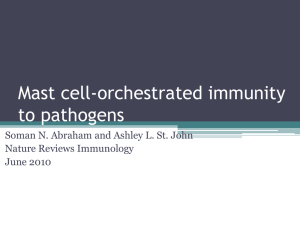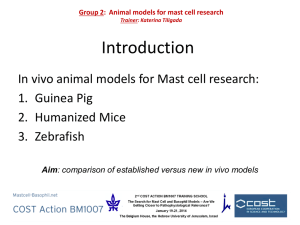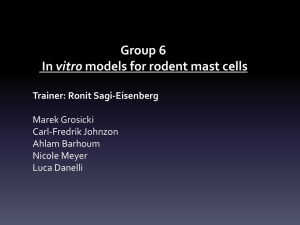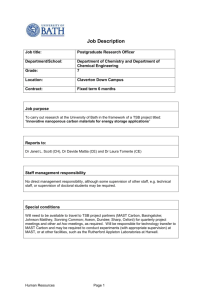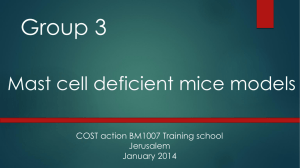Group_3_Abstract - Mast Cell
advertisement
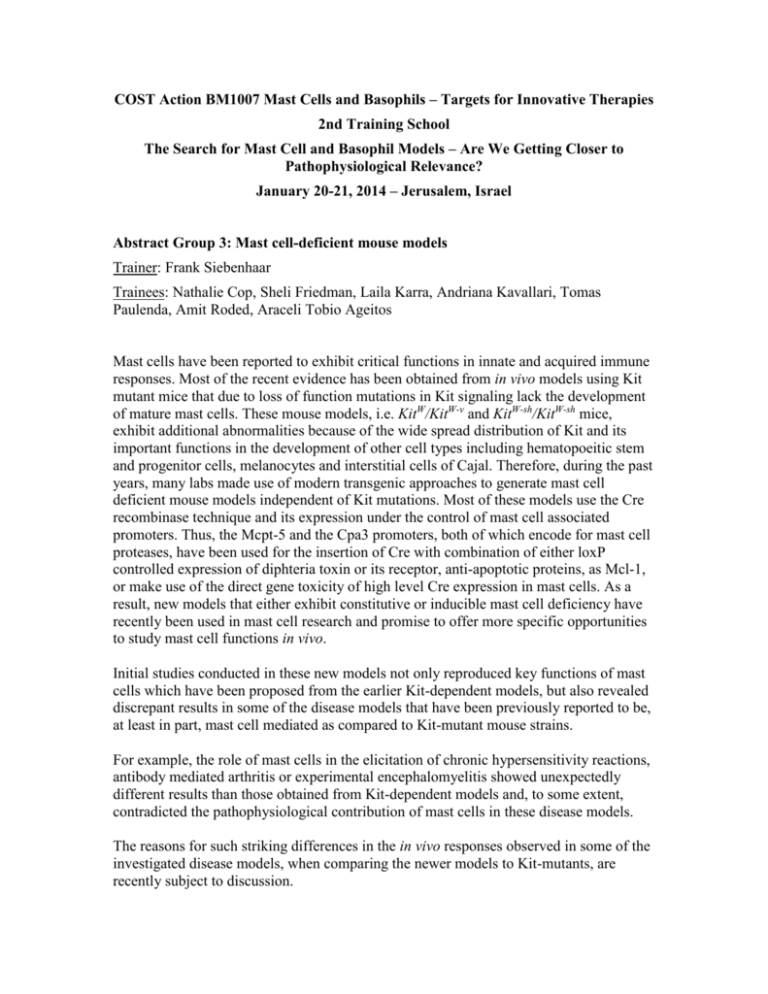
COST Action BM1007 Mast Cells and Basophils – Targets for Innovative Therapies 2nd Training School The Search for Mast Cell and Basophil Models – Are We Getting Closer to Pathophysiological Relevance? January 20-21, 2014 – Jerusalem, Israel Abstract Group 3: Mast cell-deficient mouse models Trainer: Frank Siebenhaar Trainees: Nathalie Cop, Sheli Friedman, Laila Karra, Andriana Kavallari, Tomas Paulenda, Amit Roded, Araceli Tobio Ageitos Mast cells have been reported to exhibit critical functions in innate and acquired immune responses. Most of the recent evidence has been obtained from in vivo models using Kit mutant mice that due to loss of function mutations in Kit signaling lack the development of mature mast cells. These mouse models, i.e. KitW/KitW-v and KitW-sh/KitW-sh mice, exhibit additional abnormalities because of the wide spread distribution of Kit and its important functions in the development of other cell types including hematopoeitic stem and progenitor cells, melanocytes and interstitial cells of Cajal. Therefore, during the past years, many labs made use of modern transgenic approaches to generate mast cell deficient mouse models independent of Kit mutations. Most of these models use the Cre recombinase technique and its expression under the control of mast cell associated promoters. Thus, the Mcpt-5 and the Cpa3 promoters, both of which encode for mast cell proteases, have been used for the insertion of Cre with combination of either loxP controlled expression of diphteria toxin or its receptor, anti-apoptotic proteins, as Mcl-1, or make use of the direct gene toxicity of high level Cre expression in mast cells. As a result, new models that either exhibit constitutive or inducible mast cell deficiency have recently been used in mast cell research and promise to offer more specific opportunities to study mast cell functions in vivo. Initial studies conducted in these new models not only reproduced key functions of mast cells which have been proposed from the earlier Kit-dependent models, but also revealed discrepant results in some of the disease models that have been previously reported to be, at least in part, mast cell mediated as compared to Kit-mutant mouse strains. For example, the role of mast cells in the elicitation of chronic hypersensitivity reactions, antibody mediated arthritis or experimental encephalomyelitis showed unexpectedly different results than those obtained from Kit-dependent models and, to some extent, contradicted the pathophysiological contribution of mast cells in these disease models. The reasons for such striking differences in the in vivo responses observed in some of the investigated disease models, when comparing the newer models to Kit-mutants, are recently subject to discussion. Besides some variation in the protocols that have been used in the disease models, the Cre mediated strains may also exhibit additional limitations when used as mast cell deficient mice models. This might be due to cell-intrinsic defects in other cell types, constitutive or induced expression of Cre controlling promoters in other cells than mast cells (particularly under chronic inflammatory conditions) or side effects due to diphteria toxin treatment and inflammatory responses resulting from the induction of mast cell apoptosis. In constitutive Cre expressing models it should also be considered that the lack of mast cells might result in compensatory alterations by other cells and/or the microenvironment to influence complex immune mechanisms that may lead to differential in vivo responses. No doubt that new transgenic mast cell deficient mice models will enable us to more critically discuss the role of mast cells and their functions in health and disease. The interpretation of results obtained from different mouse strains, however, requires particular consideration of potential non-specific effects regardless of the model used. The more detailed investigation of the transgenic mouse strains will definitely shed more light on the understanding of the discrepancies observed in mast cell functions in vivo. The use of Cre reporter genes in mice could be a useful tool to investigate constitutive and induced Cre expression not only under steady-state conditions but also in acute and chronic inflammatory settings in various disease models. The Kit-mutant strains may preserve their status as mast cell deficient mice models because of their wide distribution and availability. Therefore, using the Kit-mutant models as a screening tool, from which results obtained are recommended to be additionally tested and reproduced in a Kit-independent strain to gain more robust answers about the contribution of mast cells in disease models may be a useful and costeffective strategy. In addition, a close and careful investigation of the mast cell surrounding immune system in different disease models may provide more information on coincidental changes potentially able to additionally contribute to the biological readout in different mouse models and different disease conditions.

